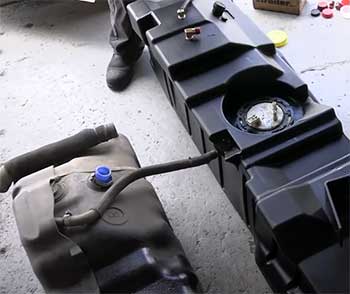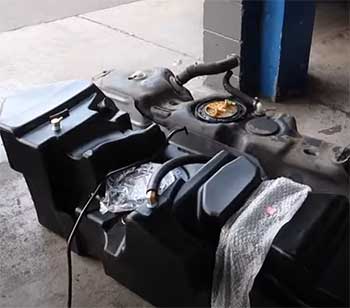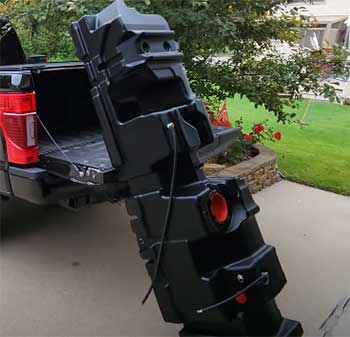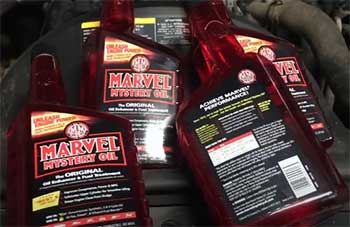S&B is one of the most popular options when it comes to aftermarket fuel tanks. But it isn’t above having problems. Inaccurate readings, vague installation guides, rust issues, and a hard setup process are the most common issues S&B fuel tank users face.
Your fuel tank should make your driving experience better, not complicate it with more issues. S&B fuel tanks are one of the top ones in the market, but how bad can the problems get?
Is it really worth it? Here’s a detailed breakdown to help you decide.
Problems With S&B Fuel Tank According To The Users
Surprisingly enough, most of the issues S&B fuel tank users face are manufacturing problems. Individual user-specific issues happen, but those are far rare.
Most problems are regarding the installation and some design issues. Problems involving faulty parts are pretty rare for S&B fuel tanks.
Some of the most common S&B fuel tank issues are inaccurate fuel reading, vague installation guide, rust issues in straps, and complicated setup processes.
Here is a quick rundown of how these issues usually unfold.
- The Meter Gets Inaccurate Readings

This is common but doesn’t happen with every unit.
S&B fuel tanks sometimes give inaccurate readings and they’re pretty far from the actual readings too.
As for the cause, this isn’t really caused by out-of-place fitting or similar things, so it is actually considered a manufacturing issue.
What happens when your fuel tank is empty but you keep getting a reading that there’s still fuel left?
Or the opposite, the reading says the tank is empty when it isn’t? Definitely a whole lot of frustration. That’s what S&B fuel tanks can give you.
Some S&B fuel tanks give the user horribly inaccurate readings. It might show the tank is ¼ full even when it is empty.
Or do the opposite, show you the tank is only 7/8 full when it is actually completely filled.
No one knows what causes this. One suspected reason is the float getting stuck inside. If the float is stuck on the line inside the tank, it can mess up the sender card and ultimately burn it.
But most of the time the issue doesn’t seem to be the card, it usually turns out to be a factory issue.
Most of the time users have to change their whole fuel tank setting to solve this problem. So you can assume that it is pretty complicated.
- The Installation Manuals Are Vague
What do you do when you don’t know how to install something? You check the manual for pointers. But what if the pointers aren’t exactly helpful?
You’re stuck and not in a good way. That’s another problem with the S&B fuel tanks. They come with super vague installation guidelines.
S&B fuel tanks are tricky to set up already. Without the proper manual and guidelines, it is next to impossible to get this thing going properly.
But the problem is, the manual that comes in the packaging doesn’t exactly have detailed directions. The pointers are generic and even the PDF versions don’t help sometimes.
This is more common with older models. New fuel tank models have better guidelines.

And if you can’t work with the manual in the packaging, you can search on the internet and you’ll find PDFs to help you out.
Plus there are lots of Youtube tutorials to help you out.
But for the older models, you have to rely on your experience.
That isn’t exactly the best thing especially if you’re a beginner (or just don’t work with fuel tanks much).
The Youtube videos can be confusing too, or they might not have a video for your model.
This isn’t really a mechanical issue, more of a factory problem. But it is an issue either way. So make sure to check for installation PDFs for your car model unless you want to end up in a pinch.
- Rear Straps Can Get Rusty Very Easily
This is a user-specific issue. Not everyone has the same problem but a lot of them do. The rear straps of the S&B fuel tank have a tendency to get rusty really fast.
This can sometimes break the straps on the back.
Fuel tanks take a good amount of pounding, in different forms. The tanks itself has to be durable but the surrounding mechanisms have to be durable too.
Losing an important part like a fuel tank because it isn’t durable enough (or doesn’t have the level of protection it should have) is a pretty big issue.
Unfortunately, that’s something S&B fuel tanks have on their bingo list of problems. The straps that hold the fuel tank become pretty sensitive to outside factors like rust.
It can get bad enough that the rust breaks the straps in a very short time.
There is no set reason behind this. Some straps break because they were already rusty or weak. But most straps seem to weaken because of the leaking issues around the fuel tank’s seams.
The leaking usually is minimal like other tanks, but they seem to wear the joints off faster especially the ones in the back.
- Setting the Tank Up Is Complicated
This somewhat ties to the vague installation guide and the leaking problem. The S&B fuel tanks are harder to set up compared to other tanks.

You’ll either need to go out of your way to find proper instructions or have a professional set it up.
A lot of people prefer setting their fuel tanks up themselves.
The reasoning is that they know what they want better and the process adds to their experiences.
This gets a little tricky with S&B fuel tanks because they’re harder to work with compared to other tanks.
Plus depending on the model, the instructions may not be very clear either.
On top of that, there’s the regular issue of leaking. Unless you’re giving professional very specific instructions, chances are the tanks will leak at the seams.
And if you’re working on it yourself, you may not even realize where you have to pay extra attention.
Because of this, most people prefer having a professional set up the fuel tank for them. But even then there’s a high chance of leaking because the tank needs very specific treatment.
Is S&B Fuel Tank Worth It?
For all its issues, S&B fuel tank is still worth it. The tanks are sturdy and you won’t have to break your bank to get them.
Plus they have more fuel capacity. If you’re aiming for that, S&B is one of the best options you’ll get your hands on.
The most important thing with this tank is to make sure the model you’re getting has a proper installation guide. And if you want to make the most of it, make sure to have a professional set it up for you.
Frequently Asked Questions (FAQ)
A small part called a baffle keeps the sloshing down.
Yes, they’re worth it. the increased mileage alone makes it well worth the price.
The gravity-fed tank has fuel stored in it and keeps replacing the fuel in the main tank as the engine burns it. This goes on until the auxiliary tank is empty too.
The three major fuel tank types are bladder, rigid removable, and internal.
Final Verdict
No fuel tank is perfect really, the same goes for S&B fuel tanks. As long as the list of S&B fuel tank problems goes, the tank itself is worth it.
All you have to do is hand the business over to a professional.

